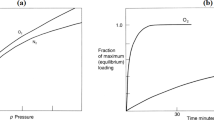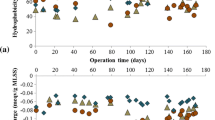Abstract
The cell surface characteristics of a methylotrophic wild-type strain of yeast, Hansenula polymorpha, was investigated at different growth stages (early log, late log, stationary and death) of the biomass under different conditions (low and high salt in intact and disrupted forms) using extended DLVO theory. Biomass was characterized by contact angle measurements as well as zeta potential determinations. These measurements were used to describe the hydrophobic, polar, and electrostatic behavior of the biomass in its growth stages. Consequently, interaction free energy vs. distance profiles of the biomass with anion-exchange and HIC adsorbents were conveniently generated. A strong interaction was calculated between cells and the adsorbents in the stationary and death phases of the biomass illustrated by the striking correlation between theoretical predictions and biomass deposition experiments. The physico-chemical properties of biomass in different growth phases have important implications for expanded bed adsorption chromatography, where unfavorable biomass-adsorbent interactions adversely affect process efficiency.
Similar content being viewed by others
References
Walsh, G. (2012) A review of new biologic drug approvals over the years, featuring highlights from 2010 and 2011. BioPharm. Int. 25: 34–38.
Reichert, J. and C. Paquette (2003) Therapeutic recombinant proteins: Trends in US approvals 1982 to 2002. Curr. Opin. Mol. Ther. 5: 139–147.
Anspach, F. B., D. Curbelo, R. Hartmann, G. Garke, and W. -D. Deckwer (1999) Expanded-bed chromatography in primary protein purification. J. Chromatogr. A. 865: 129–144.
Wheelwright, S.M. (1991) Protein Purification: Design and Scale Up of Downstream Processing. Hanser Publishers.
Harrison, R. G., P. Todd, S. R. Rudge, and D. P. Petrides (2003) Bioseparations Science and Engineering. Oxford University Press, NY.
D’Souza, R. N., A. M. Azevedo, M. R. Aires-Barros, N. L. Krajnc, P. Kramberger, M. L. Carbajal, M. Grasselli, R. Meyer, and M. Fernández-Lahore (2013) Emerging technologies for the integration and intensification of downstream bioprocesses. Pharm. Bioproc. 1: 423–440.
Chase, H. A. (1994) Purification of proteins by adsorption chromatography in expanded beds. Trends Biotechnol. 12: 296–303.
Feuser, J., J. Walter, M. -R. Kula, and J. Thömmes (1999) Cell/adsorbent interactions in expanded bed adsorption of proteins. Bioseparation 8: 99–109.
Barnfield Frej, A. -K., R. Hjorth, and Å. Hammarström (1994) Pilot scale recovery of recombinant annexin V from unclarified Escherichia coli homogenate using expanded bed adsorption. Biotechnol. Bioeng. 44: 922–929.
Calado, C. R. C., J. M. S. Cabral, and L. P. Fonseca (2002) Effect of Saccharomyces cerevisiae fermentation conditions on expanded bed adsorption of heterologous cutinase. J. Chem. Technol. Biotechnol. 77: 1231–1237.
Beck, J. T., B. Williamson, and B. Tipton (1999) Direct coupling of expanded bed adsorption with a downstream purification step. Bioseparation 8: 201–207.
Blank, G. S., G. Zapata, R. Fahrner, M. Milton, C. Yedinak, H. Knudsen, and C. Schmelzer (2001) Expanded bed adsorption in the purification of monoclonal antibodies: A comparison of process alternatives. Bioseparation 10: 65–71.
Timo May, K. P. (2011) Improving process economy with expanded-bed adsorption technology. Bioproc. Int. 9: 32–36.
Walter, J. K. and J. Feuser (2003) Novel approach and technology in expanded bed adsorption techniques for primary recovery of proteins at large technical scale. Proceedings of the Extended reports from the 4th International Conference on Expanded Bed Adsorption.
Lin, D. Q., H. M. Fernandez-Lahore, M. R. Kula, and J. Thommes (2001) Minimising biomass/adsorbent interactions in expanded bed adsorption processes: A methodological design approach. Bioseparation. 10: 7–19.
Fernández-Lahore, H. M., R. Kleef, M. R. Kula, and J. Thömmes (1999) The influence of complex biological feedstock on the fluidization and bed stability in expanded bed adsorption. Biotechnol. Bioeng. 64: 484–496.
Vennapusa, R., S. M. Hunegnaw, R. B. Cabrera, and M. Fernandez-Lahore (2008) Assessing adsorbent-biomass interactions during expanded bed adsorption onto ion exchangers utilizing surface energetics. J. Chromatogr. A. 1181: 9–20.
Fernández-Lahore, H. M., S. Geilenkirchen, K. Boldt, A. Nagel, M. R. Kula, and J. Thömmes (2000) The influence of cell adsorbent interactions on protein adsorption in expanded beds. J. Chromatogr. A. 873: 195–208.
Poulin, F., R. Jacquemart, G. de Crescenzo, M. Jolicoeur, and R. Legros (2008) A study of the interaction of HEK-293 cells with streamline chelating adsorbent in expanded bed operation. Biotechnol. Progr. 24: 279–282.
Smith, M. P., M. A. Bulmer, R. Hjorth, and N. J. Titchener-Hooker (2002) Hydrophobic interaction ligand selection and scale-up of an expanded bed separation of an intracellular enzyme from Saccharomyces cerevisiae. J. Chromatogr. A. 968: 121–128.
Skvarla, J. (1993) A physicochemical model of microbial adhesion. J. Chem. Soc. Faraday Tran. 89: 2913–2921.
Kondo, A., and M. Ueda (2004) Yeast cell-surface display - applications of molecular display. Appl. Microbiol. Biot. 64: 28–40.
Ravin, N. V., M. A. Eldarov, V. V. Kadnikov, A. V. Beletsky, J. Schneider, E. S. Mardanova, E. M. Smekalova, M. I. Zvereva, O. A. Dontsova, A. V. Mardanov, and K. G. Skryabin (2013) Genome sequence and analysis of methylotrophic yeast Hansenula polymorpha DL1. BMC Genomics. 14: 837.
Ma, Y., M. Zhou, S. Walter, J. Liang, Z. Chen, and L. Wu (2014) Selective adhesion and controlled activity of yeast cells on honeycomb-patterned polymer films via a microemulsion approach. Chem. Commun. 50: 15882–15885.
Kurec, M., and T. Branyik (2011) The role of physicochemical interactions and FLO genes expression in the immobilization of industrially important yeasts by adhesion. Colloids Surf., B. 84: 491–497.
Bou Zeidan, M., G. Zara, C. Viti, F. Decorosi, I. Mannazzu, M. Budroni, L. Giovannetti, and S. Zara (2014) L-histidine inhibits biofilm formation and FLO11-associated phenotypes in Saccharomyces cerevisiae flor yeasts. PloS one. 9: e112141.
Vennapusa, R. R., C. Tari, R. Cabrera, and M. Fernandez-Lahore (2009) Surface energetics to assess biomass attachment onto hydrophobic interaction adsorbents in expanded beds. Biochem. Eng. J. 43: 16–26.
Ottewill, R. H. and J. N. Shaw (1972) Electrophoretic studies on polystyrene latices. J. Electroanal. Chem. Interfacial Electrochem. 37: 133–142.
Farahat, M. and T. Hirajima (2012) Hydrophilicity of Ferroplasma acidiphilum and its effect on the depression of pyrite. Miner. Eng. 36–38: 242–247.
Lipke, P. N. and J. Kurjan (1992) Sexual agglutination in budding yeasts: Structure, function, and regulation of adhesion glycoproteins. Microbiol. Rev. 56: 180–194.
Tari, C., R. Vennapusa, R. B. Cabrera, and M. Fernández-Lahore (2008) Colloid deposition experiments as a diagnostic tool for biomass attachment onto bioproduct adsorbent surfaces. J. Chem. Technol. Biotechnol. 83: 183–191.
Kucsera, J., K. Yarita, and K. Takeo (2000) Simple detection method for distinguishing dead and living yeast colonies. J. Microbiol. Methods. 41: 19–21.
Sharma, P. K. and K. Hanumantha Rao (2002) Analysis of different approaches for evaluation of surface energy of microbial cells by contact angle goniometry. Adv. Colloid. Interface Sci. 98: 341–463.
Huang, A. Y. and J. C. Berg (2006) High-salt stabilization of Laponite clay particles. J. Colloid. Interface Sci. 296: 159–164.
van Oss, C. J. (2006) Interfacial Forces in Aqueous Media. 2nd ed. Taylor & Francis, Boca Raton.
Vennapusa, R. R., M. Aasim, R. Cabrera, and M. Fernandez-Lahore (2009) Surface energetics to assess biomass attachment onto immobilized metal-ion chromatography adsorbents in expanded beds. Biotechnol. Bioproc. Eng. 14: 419–428.
Vennapusa, R. R., O. Aguilar, J. M. B. Mintong, G. Helms, J. Fritz, and M. F. Lahore (2010) Biomass-adsorbent adhesion forces as an useful indicator of performance in expanded beds. Separ. Sci. Technol. 45: 2235–2244.
Vennapusa, R. R., S. Binner, R. Cabrera, and M. Fernandez-Lahore (2008) Surface energetics to assess microbial adhesion onto fluidized chromatography adsorbents. Eng. Life Sci. 8: 530–539.
Farahat, M., T. Hirajima, K. Sasaki, and K. Doi (2009) Adhesion of Escherichia coli onto quartz, hematite and corundum: Extended DLVO theory and flotation behavior. Colloids Surf. B. 74: 140–149.
Lin, D. -Q., P. J. Brixius, J. J. Hubbuch, J. Thömmes, and M. -R. Kula (2003) Biomass/adsorbent electrostatic interactions in expanded bed adsorption: A zeta potential study. Biotechnol. Bioeng. 83: 149–157.
Lin, D. -Q., L. -N. Zhong, and S. -J. Yao (2006) Zeta potential as a diagnostic tool to evaluate the biomass electrostatic adhesion during ion-exchange expanded bed application. Biotechnol. Bioeng. 95: 185–191.
Author information
Authors and Affiliations
Corresponding author
Rights and permissions
About this article
Cite this article
Naz, N., Dsouza, R.N., Yelemane, V. et al. Growth-dependent surface characteristics of Hansenula Polymorpha: implications for expanded bed adsorption chromatography. Biotechnol Bioproc E 20, 576–584 (2015). https://doi.org/10.1007/s12257-014-0397-6
Received:
Revised:
Accepted:
Published:
Issue Date:
DOI: https://doi.org/10.1007/s12257-014-0397-6




